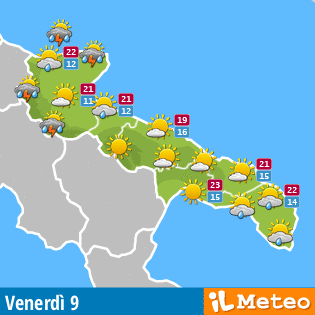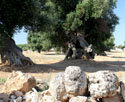Sea places
Long coasts and a crystal clear sea
Apulia is a peninsula surrounded by the sea and characterized by kilometers of coast which appears now very high and sheer to the sea now low and sandy. From the white indented Gargano cliffs to the golden beaches of the Salento with its beautiful crystal clear sea.
Castro marina, a village of fishermen at the feet of the medieval city
Castro marina is well known for its crystal waters and its main attraction is surely represented by the sea caves which are situated in the northern area of the town. During the Hellenic domination (4th century B.C.) the zone was used as extractive cave; it is during the Middle Ages that it became a little rocky centre with its small port.
The enchanting old town centre of Gallipoli standing on an island
Kalé polis, the beautiful city. This is the name the Greeks gave it. Gallipoli is sited along the west coast of the Salento peninsula; it overlooks the Ionian sea and appears divided into two different parts that is to say the suburb and the old town centre, which are bound together by a 17th - century stone bridge with seven spans.
Mattinata: sea, mountains and a wonderful view
The town of Mattinata stands on the central-southern side of the Gargano promontory. Sea and mountains characterize this territory, where it is possible to admire golden beaches, clean cliffs, hilly pastures, Aleppo pine, holms and oak woods. Here we find the most typical aspects characterizing the area of the Gargano National Park.
Monopoli and its suggestive and lively old town centre
Situated on the sea and surrounded by old Messapic walls which date back to the 5th century B.C., Monopoli is one of the most important ports in the Adriatic sea and it is characterized by a very lively old town centre. With its suggestive and characteristic atmosphere, it dates back to Early Middle Ages; it was built on the ruins of an important Messapic town.
Otranto, the most eastern city of Italy. Great charm and ancient origins
It is the most eastern city of Italy, with extraordinary charm and ancient origins. The area of Otranto was probably already peopled during the Paleolithic age. Subsequently it was inhabitated by Messapi, Greeks and Normans. Thanks to its strategic geographical position, it was an important trading, politic and religious centre, especially during the Byzantine and Norman period, being a sort of bridge between East and West.
Peschici, a characteristic old town centre on a promontory
Peschici was founded around the year one thousand, when Dalmatians and Schiavoni settled here to stem Saracen raids. It shows a characteristic old town centre, on a 90 metres high promontory falling sheer to the sea it is possible to admire the white single-storey houses and the dome-shaped roofs following the Arabian style.
Polignano a Mare stands on a cliff falling sheer to the Adriatic sea
On the top of a cliff that falls sheer to the sea being 24 metres high in the highest point, stands the old town of Polignano, where the coast is characterized by erosive phenonema and inlets. It has Greek origins but some scholars assert that it was already peopled during the prehistoric age.
Porto Selvaggio, Regional Natural Park
Porto Selvaggio belongs to the territory of Nardò and it has been declared protected area and Regional Natural Park in 1980. The protected area extends over 420 hectares, for the greatest part covered by woods. It is worth mentioning the presence of the wonderful Mediterranean maquis with alternate imposing falaises, sheer to the sea.
San Pietro In Bevagna

Santa Cesarea Terme, an ancient thermal place
It is a famous thermal place developed in the 1920s but it was already known in antiquity thanks to the presence of sulphureous thermal waters. They gush out of four caves (Gattulla, Solfatara, Fetida, Sulfurea). According to the myth these sources are linked with the birth of four Leuterni giants, killed by Hercules with strokes of club
Santa Maria di Leuca is the farthest end of Salento
Romans called it “De Finibus Terrae”. Santa Maria di Leuca is the farthest end of Salento, the “heel” of Italy, point of contact between the Adriatic Sea and the Ionian Sea.On the top of the promontory, dominating the coast, stands the Basilica-Sanctuary of Santa Maria de Finibus Terrae, ancient place of pilgrimage.
Savelletri a little maritime village
It is a little maritime village with beautiful crystal clear waters, on the coast road between Monopoli and Fasano; it is well known thanks to its sandy beaches with alternate rocky areas. Savelletri is also famous for its marine: in its port it is possible to moor nearly 300 boats.
Torre dell'Orso, dunes and beaches alternate with high cliffs
On the coast road between San Cataldo and Otranto, the territory offers an extremely interesting natural panorama, with dunes and beaches alternate with high cliffs. The name Torre dell’Orso comes from the presence of a 16th – century sighting tower, today in ruins.
Tremiti islands, an archipelago of uncontaminated nature
It is an archipelago of uncontaminated nature, 22 km out to the coast of Gargano, which is formed by three main islands: San Nicola, San Domino and Capraia, to which we add the little island of Cretaccio and the farther Pianosa. These islands are also called Diomedee because the myth says that, after the Trojan war, the hero Diomede had been buried exactly here.
Vieste the old town centre is really charming
The town of Vieste is the main centre of the Gargano; it is particularly famous for its beautiful waters. The old town centre is really charming: it is characterized by typical white houses and narrow alleys leading to little squares. The upper part of the town stands on the part of the promontory known as Punta San Francesco, marked by a fortified monastery and the Norman-Swabian castle.

 Home PUGLIA
Home PUGLIA Places to visit
Places to visit Sea places
Sea places Ancient villages
Ancient villages Salento
Salento Gargano
Gargano Tremiti Islands
Tremiti Islands Valle D'Itria
Valle D'Itria Lecce Baroque
Lecce Baroque Holy sites
Holy sites Olive groves
Olive groves Sitemap
Sitemap


























